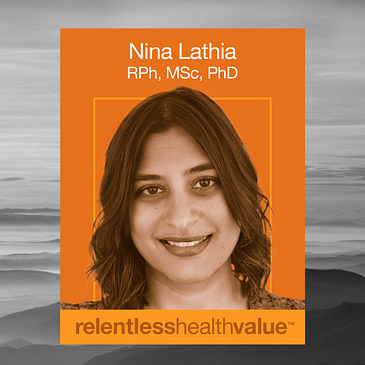For a full transcript of this episode, click here.
Here’s something Randy Vogenberg, PhD, wrote the other day; and I made some light edits: Research has documented the unintended impacts of poor pharmacy benefit strategy. Examples include increasing costs of care, bankruptcies, and member satisfaction declines.
And, yeah … agreed. Also, probably health problems if we’re talking about a member unable to access a drug they really need. I heard the other day about how so many patients who have had organ transplants have a hard time getting their transplant rejection meds. What?! I just can’t even with that one. On the other hand, you could have a plan that pays for all manner of drugs, cost-effective or not, appropriate or not.
And now we have premiums that no one can afford, and everybody loses for the exact opposite reason. These are the downsides that happen when pharmacy purchasing gets itself into a suboptimal place. And this can happen for many reasons, but one of them is when there is not a concerted effort to buy pharmaceuticals in a value-based way.
Now, here’s some reasons why employers may have a rough time paying for value (ie, paying a fair price for drugs that work).
Here’s one reason: Most employers do not have the power to influence the price of a medication. So, any given employer could decide, based on some cost-effectiveness analysis, that the price of a drug is too high. But it’s not like they can march into Pharma HQ and haggle. It’s more of a take-it-or-leave-it kind of thing.
Here’s a number two reason why value-based pharmacy purchasing can be tough: Pharmacy spend is siloed a lot of times from medical spend. So, the pharmacy vendor is only concerned about cost and denies access to even drugs that are proven to reduce medical spend.
Why wouldn’t they do that? The PBM (pharmacy benefit manager) was hired to reduce pharmacy spend. The end. Who cares how many ER visits or disease exacerbations transpired? That’s the medical director’s problem, not theirs.
Here’s the number three reason why value-based purchasing is rough: The time horizon an employee is with an employer, which is not one day—and it’s not a lifetime. Why did I say one day? I have heard more than once that the actuarial time horizon that some pharmacy plans use to determine if a drug is cost-effective is one day. If the drug doesn’t accrue any benefits in one day, well then, it’s a cost. It’s not effective.
On the other hand (and also problematic in the real world), sometimes cost-effectiveness analyses are done with a timeframe of the patient’s lifetime. And, yeah … there aren’t many employers who have employees for a lifetime—like, they’re 85 years old and still on the employer’s dime—so the time horizon can’t be too short.
But if it’s a really expensive med that will, at most, prevent something that’s not gonna happen anytime soon (heart failure, kidney failure, a stroke), these are things that an employer may pay for but likely is never gonna see the cost benefit of because that benefit will happen 30 years from now when the patient is on Medicare.
And here’s a fourth reason why value-based purchasing is tough: The FDA is approving drugs based on evidence from one study (ie, not a ton of evidence). And these drugs are also really expensive.
So, some of the above issues are solvable; some are less solvable. With this in mind, let’s tick through some advice that my guest today, Nina Lathia, suggests if you want to offer members a value-based formulary.
1. Have a stated goal. And maybe that stated goal is to meaningfully improve health of plan members while maintaining access, satisfaction, and affordability for said plan members and the plan.
2. Think holistically about healthcare spend, not just pharmacy spend.
3. Know what the value-based price of a drug has been calculated to be. I talked about this at length in the show with Anna Kaltenboeck (EP303). Also, Bryce Platt, PharmD, has written about this a lot.
4. Look into risk-based deals with Pharma and/or installment payments and/or some of these other interesting payment models that are emerging. Luke Prettol linked to one of them the other day.
5. Set good decision-making precedents that include shared decision-making with members/patients. This means communicating with employees and plan members about what you are doing to make good drug purchasing decisions and evaluate the clinical pros and cons of expensive drugs for any given patient. There are genetic tests now that can be done to determine if a drug is ever going to work for a patient, were these tests even done.
I mean, from a patient standpoint, some of these drugs have horrible side effects; and they might be being prescribed by a doc who’s not an expert in that condition. If I’m a patient and there’s a genetic test I could take before I pay a ton of my own money and subject myself to what might be some pretty nasty side effects (you know, all the things that you hear about at the ends of those pharma ads on TV, right?), this could be, in the right hands, a patient benefit. This feels very different from prior auths administered by a vendor doing all kinds of stuff, where it’s hard to make any connections to clinical value or patient upside, even if you squint at it sideways and use your imagination.
And, yeah … this is easy to say and really hard to do.
One definition I want to chuck in here for you: If we’re talking about a cost-effectiveness analysis, cost-effectiveness analyses calculate how effective is the drug, minus side effects at diminishing the so-called burden of illness—burden of illness meaning the financial and health costs of the disease itself or its exacerbations.
Nina Lathia, my guest today, is a pharmacist by training who has worked in hospital pharmacies. She earned a PhD in health economics. Currently she’s doing consulting work, helping purchasers make value-based decisions about pharmacy spend and managing formularies.
Specialty Pharmacy Playlist: https://lnns.co/uNZ3moCaQMb
Hit the subscribe button to add it to your podcast player.
Also mentioned in this episode are Randy Vogenberg, PhD; Anna Kaltenboeck; Bryce Platt, PharmD; Luke Prettol; Olivia Webb; Pramod John, PhD; Scott Haas; Aaron Mitchell, MD, MPH; Keith Hartman, RPh; Erik Davis; Autumn Yongchu; and Berkley Accident and Health.
You can learn more by emailing Nina at nina.lathia@healthcaredecisionmaking.com.
You can also connect with her on LinkedIn.

As the chief executive officer of Healthcare Decision Making, Nina works with public and private healthcare payers, helping them to make evidence-based decisions about their pharmaceutical benefits that lead to improved health outcomes and long-term financial sustainability of their health plans. Her focus is on providing independent, actionable advice for healthcare payers on reimbursement decisions related to expensive new drug therapies.
Nina is a frequent public speaker and commentator on employer-sponsored pharmacy benefits design, value-based healthcare decision-making, and evidence-based medicine.
Nina honed her skills in value-based assessment of drug therapies when she was a senior technical advisor at the National Institute for Health and Care Excellence (NICE) in the United Kingdom from 2014 to 2017. She has also worked as a clinical lecturer at the University of Toronto. Her work has been published in a number of high-impact peer-reviewed journals.
Nina holds a master’s degree and doctorate in health economics from the University of Toronto.
06:34 What does cost containment mean?
07:43 Why is it important to consider health outcomes?
10:00 What does value-based purchasing mean in Pharma?
11:09 What are the principles of cost-effectiveness analysis?
12:50 Pharmacy plan time horizons versus employer time horizons.
14:42 Why is it increasingly important for payers to take a more global look at health and cost outcomes?
16:14 Why is the first step establishing a value-based price for drugs?
16:43 Why is the second step thinking about risk-sharing agreements with manufacturers?
18:57 LinkedIn article by Bryce Platt, PharmD.
19:20 What should an employer do if there’s only one drug option and the price is too high?
21:20 What’s a specialty carve-out solution?
21:26 EP352 and EP353 with Pramod John, PhD, of VIVIO.
22:10 Why should employers get more comfortable with saying “no” to certain drugs?
25:36 Why is patient engagement key?
28:23 What does “good” look like for employers implementing drug-spend changes?
You can learn more by emailing Nina at nina.lathia@healthcaredecisionmaking.com.
You can also connect with her on LinkedIn.
Recent past interviews:
Click a guest’s name for their latest RHV episode!
Marshall Allen, Stacey Richter (INBW39), Peter Hayes, Joey Dizenhouse, Benjamin Jolley, Emily Kagan Trenchard (Encore! EP392), Cora Opsahl (Encore! EP372), Jodilyn Owen, Ge Bai, Andreas Mang




